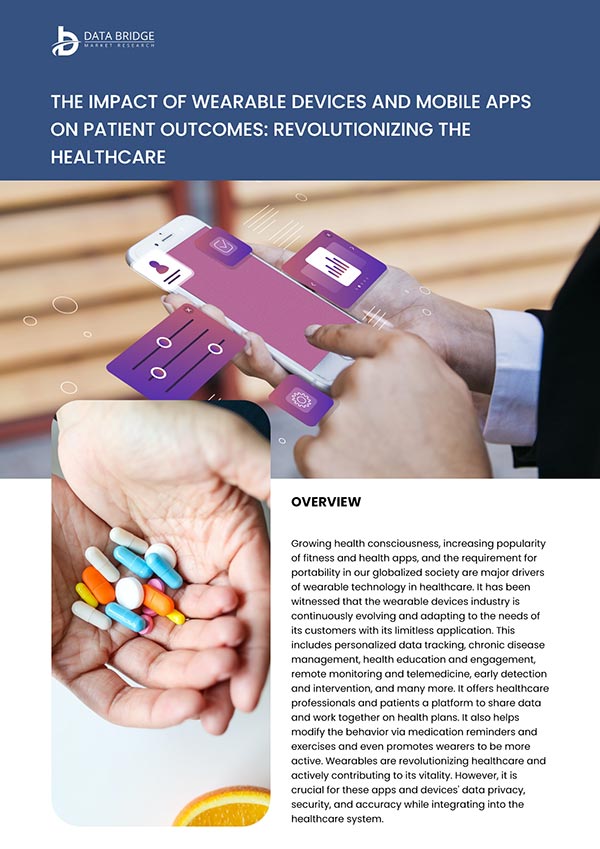Overview
Growing health consciousness, increasing popularity of fitness and health apps, and the requirement for portability in our globalized society are major drivers of wearable technology in healthcare. It has been witnessed that the wearable devices industry is continuously evolving and adapting to the needs of its customers with its limitless application. This includes personalized data tracking, chronic disease management, health education and engagement, remote monitoring and telemedicine, early detection and intervention, and many more. It offers healthcare professionals and patients a platform to share data and work together on health plans. It also helps modify the behavior via medication reminders and exercises and even promotes wearers to be more active. Wearables are revolutionizing healthcare and actively contributing to its vitality. However, it is crucial for these apps and devices' data privacy, security, and accuracy while integrating into the healthcare system.
In recent years, the utilization of wearable devices has increased significantly due to the rising trend of all generations going digital and focusing on a healthy and active lifestyle. As the number of consumers- and medical-grade wearables will continue to rise in the next years, Fitbit Inc., Garmin Ltd., Samsung, Xiaomi Inc., and others are considering using healthcare app development and different software solution to capitalize on the potential of these cutting-edge devices. Adding to this, predictive analytics methods combined with Internet of Things (IoT) technologies will assist in providing additional information about patient data. The effectiveness of wearable products will be increasingly affected by the development of artificial intelligence in healthcare. It can not only reduce cybersecurity threats but also improve measurement accuracy. Despite its profitability with these technologies, telemedicine software is not cheap, and not all healthcare providers may be able to provide digital solutions for their patients.
Client Challenges
The client wants to enter the market, for which he needs to analyze the overall market scenario concerning smart wearable medical devices. Following were the requirements asked by the client:
- Key factors affecting the adoption of wearable devices
- Regulatory requirements on country level to avoid legal issues and product recalls
- Potential market size and units for wearable devices product for forecast year 2022-2030
- Future growth rate for the required market
- Competitive analysis of both leading players and market disruptors
- Current and future technological trends
- Trade policy in relation with wearable products
- Consumer preferences and buying patterns along with their feedback
- Suitable marketing platform and ideas adopted by other players
- Pricing analysis on different wearable device brands
- Product differentiation strategies adopted by various companies
- List of component manufacturers for wearable devices
Dbmr Approach/Research Methodology
Data Bridge Market Research followed a tripod model for analyzing and validating data to provide valuable insights based on client requirements. DBMR's approach or research methodology for wearable device market is explained below:
- DBMR conducted secondary and primary research for both top-down and bottom-up data analysis and validation methods. This approach was utilized to access qualitative and quantitative data for each mentioned segment on global, regional and country level data.
- Secondary research includes literature survey wherein it covers data published by government associations, annual reports, investor presentations, press releases, certified publications, white papers, articles from recognized authors, and many more. Data from various paid sources such as Hoovers, Factiva, and others are also used.
- Primary research incorporates in-depth interviews with various primary respondents via cold calling, e-mail, LinkedIn and others, with key industry participants, subject-matter experts (SMEs), C-level executives of key market players, and industry consultants, to obtain and verify critical qualitative and quantitative information.
- All factors namely drivers, restraints, opportunities and challenges affecting the overall wearable device and mobile apps market were studied
- Analysis of key drivers, restraints, opportunities, and challenges which can impact the overall market growth of digital payment and online shopping/e-commerce
- Company comparative analysis was done considering several factors, namely trackable revenue, strength & weakness, research & development activities, market share, growth rate, product positioning, application grid and strategic initiatives among others
Hence, by following the above-mentioned approach, market insights were provided to the client accordingly.
Outcome And Business Impact
Following are the outcomes were found while analyzing the medical wearable devices and mobile app market:
- Market size and units of medical wearable devices and mobile app market along with growth rate for financial year 2022-2030 on global, regional and country level was provided to comprehend the market potential for each segment
- Factors influencing the adoption of wearable devices market for healthcare applications in both positive and negative aspects along with related figures and statistics
For instance,
While manufacturing the smart wearable medical device, manufacturers faces several challenges such as components miniaturization, data security, power management regulatory compliances, and manufacturing cost. For this, solution were also suggested to overcome these challenges. Micro-electromechanical systems (MEMS) technology must be used to manufacture light weighted and small sensor to integrate it into wearable medical devices. Moreover, this technology is considered to be cost effective thus, making it perfect for mass production
- Regulatory frameworks and certifications affecting the production to distribution has been provided with the client on country level in order to plan the entire process before entering or investing into the untapped markets
- Company comparative analysis was shared in terms of company profiling, company landscape, market positioning grid, SWOT, application grid, strategic initiatives (product launch, merger & acquisition, partnership, expansion) and others for recognizing the market competition amongst each players
- Insights on technological advancements including Internet of Things (IoT), Artificial Intelligence (AI), 5G, Big Data & Analytics, GPS trackers, biosensors and others was also shared for innovative product development and implementation
- The report also incorporate the trade data which highlight the top as well as average/below level countries for both exporting and importing the goods
- Both positive and negative feedback stated by varied customers on different wearable product type was also integrated under the scope to understand the ongoing demand and other related trends associated with it
- Pricing list quoted by the vendors was also represented in our report in order to build a pricing strategy. The pricing decision covers the selling price, the discounts, and any price-matching services if offered
Conclusion:
Data Bridge Market Research has provided in-depth insights concerning the medical wearable devices and mobile apps to cater to each requirement. Adding to this, the report's factual and consolidated information will help the client to evaluate the company's growth in terms of technology, penetration and can also be further utilized for decision-making and future planning. Apart from this, the client can even access/capture the business opportunities from the reports' information.



